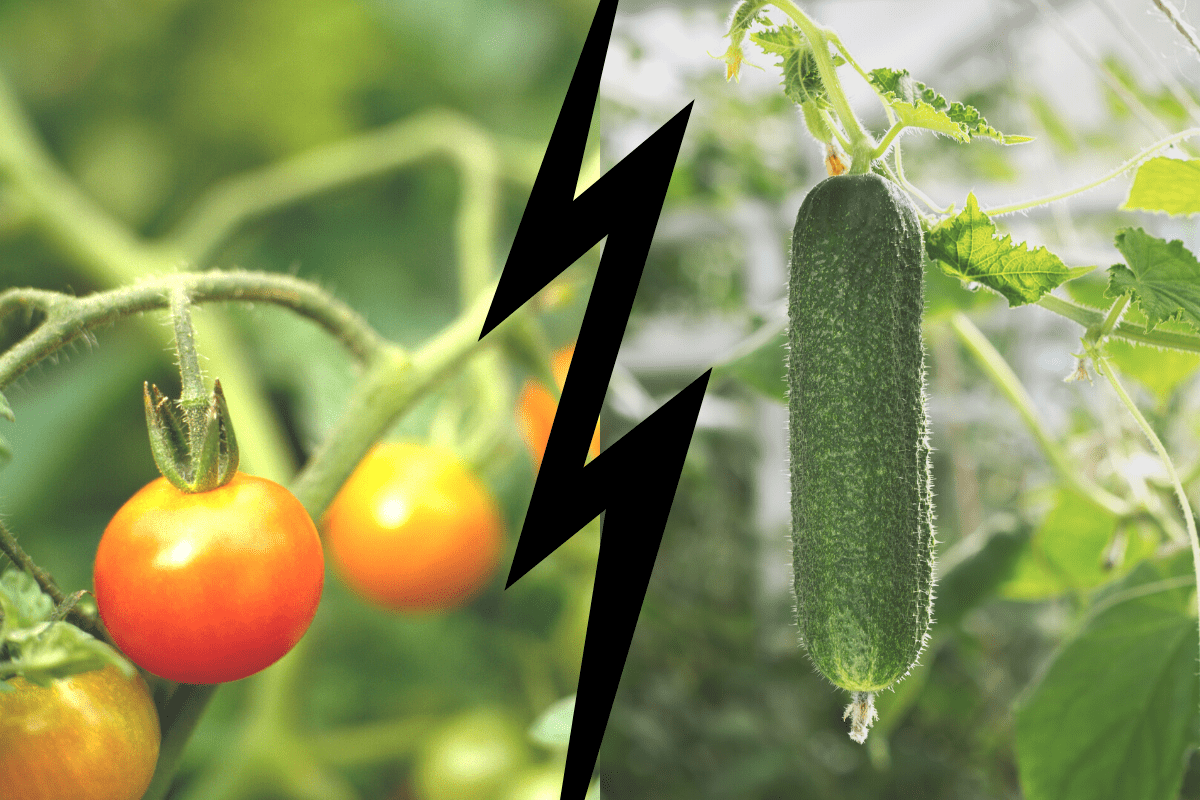Despite a few benefits to planting cucumbers near tomatoes, there is one significant danger in doing so:
You should not plant cucumbers near tomatoes because of the possibility of shared diseases such as Cucumber Mosaic Virus and Phytophthora Blight. Both diseases quickly spread from one species to the other one both ways. Once a plant is infected, unfortunately, there is no cure.
That is why you should avoid planting cucumbers and tomatoes close to each other in your garden. If you spot any symptoms of the two diseases on your plants, remove and destroy them immediately to minimize the damage and avoid further spreading.
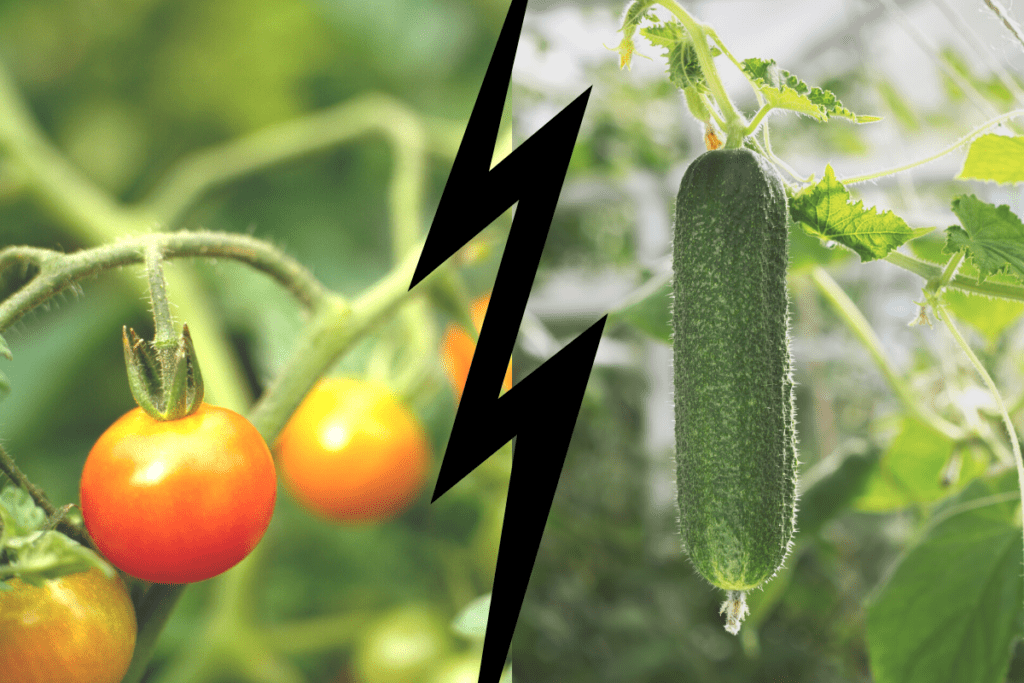
Cucumber Mosaic Virus
The cucumber mosaic virus (CMV) is a small RNA virus capable of infecting cucumbers and a wide variety of plant species. Typical symptoms of this virus include yellowing of leaves and turning them mosaic, appearing ring spots, growth stunting, and flower and fruit distortion.
CMV can cause the cucumbers (fruit) to turn pale and bumpy. Usually, the overall growth of affected plants is stunted, and fewer flowers are produced.
Aphids spread the virus. Within seconds a cucumber plant can be infected, and the disease can be distributed around a garden within a few hours. CMV is one of the broadest spread plant viruses all over the world.
Apart from cucumbers and tomatoes, the disease also attacks spinach, lettuce and celery, and many different kinds of flowers.
Unfortunately, the cucumber mosaic virus can’t be cured. It is best controlled through prevention of the infection and eradication. If you spot infected plants in your garden, remove them as soon as possible and use clean and sanitized tools to start over.
Since there is no cure for CMV, prevention is key!
Phytophthora Blight
Phytophthora blight is caused by the water mold Phytophthora capsici.
The disease causes root, crown, and fruit rot in cucumber and tomato plants.
Other cucurbits, pepper, and eggplant can also be affected. The disease spreads either through direct contact with spores-infested soil or from splashing rain and irrigation.
Initially, symptoms on cucumbers and tomatoes will appear as small water-soaked areas on the fruit. These quickly enlarge in high humidity conditions. The resulting lesions will have a yeast-like, grey to white appearance. The rot will develop rapidly until the fruit completely collapses.
To avoid Phytophthora blight in your garden, never randomly dump culled fruit or plants in or around your garden beds. Ensure good water management, promote good drainage and use un-infested water.
If you do spot infected plants in your garden, remove them immediately to minimize the damage and avoid further spreading.
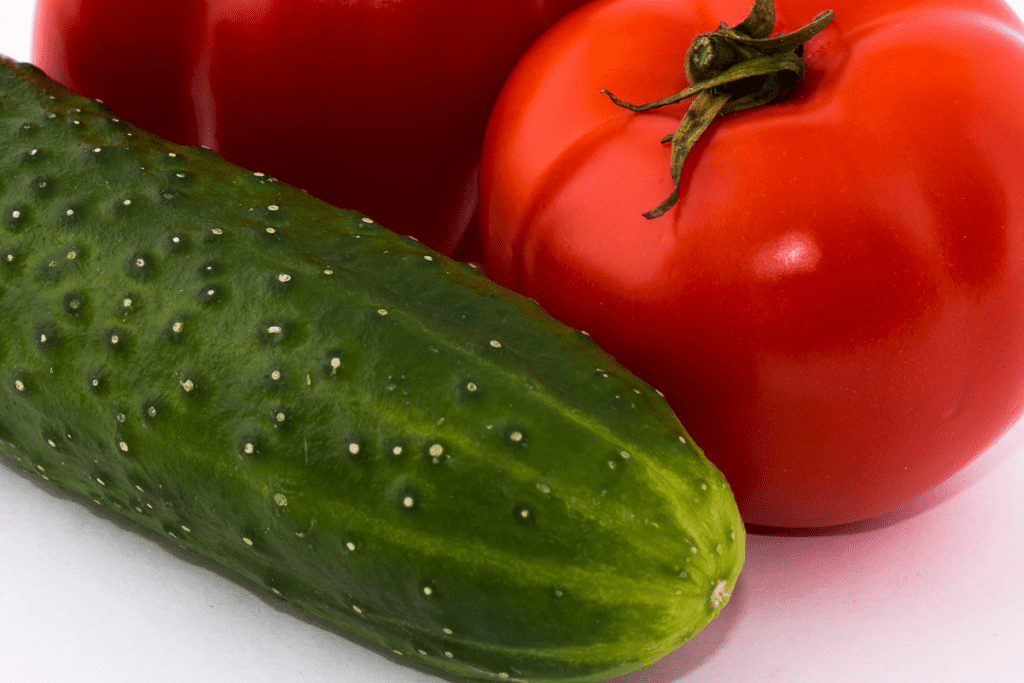
Companion planting
Companion planting is officially defined as the close planting of different plants that enhance each other’s growth or protect each other from pests.
The companion plants benefit each other through repelling insect pests, attracting beneficial insects, improving soil nutrients, encouraging faster growth and better taste, providing ground cover, or providing necessary shade.
The ultimate goal of companion planting is to increase crop productivity effectively.
The whole concept of companion planting is based on experience, and not every chart out there will give you the exact same ideal plant combinations.
So, can you plant tomatoes and cucumbers next to each other?
You might even find charts mentioning cucumbers as great companion plants for tomatoes. In fact, they can do well together in similar soil conditions and take around the same to grow and be ready for harvest.
However, due to the possibility of shared diseases such as Cucumber Mosaic Virus and Phytophthora Blight, it is highly recommended NOT to plant cucumbers and tomatoes as companion plants. Instead, space them far apart in your garden and choose other, safe companions for your crops.
Companion plants for cucumbers
Let’s have a look at what is good and safe to plant with cucumbers:
– Corn and sunflowers
Corn stalks can serve as a natural trellis for vining cucumbers, which is a great way to save space and maximize garden efficiency.
– Oregano and dill
Oregano perfectly repels insect pests, and dill attracts beneficial predatory insects to the garden, which helps rid it of pests.
– Legumes
Legumes such as peas, beans, and lentils have a root system that increases nitrogen in the soil and will significantly benefit your cucumbers.
Other good vegetable companions include root vegetables like radishes, beets, carrots, and onions.
– Marigolds and nasturtiums
Marigolds are excellent companion plants for cucumbers. Their flowers will help repel beetles, and nasturtiums are distasteful to certain insects that feed on cucumbers
– Sunflowers
Like corn stalks, you can use sunflower stalks as a natural trellis for vining cucumbers.
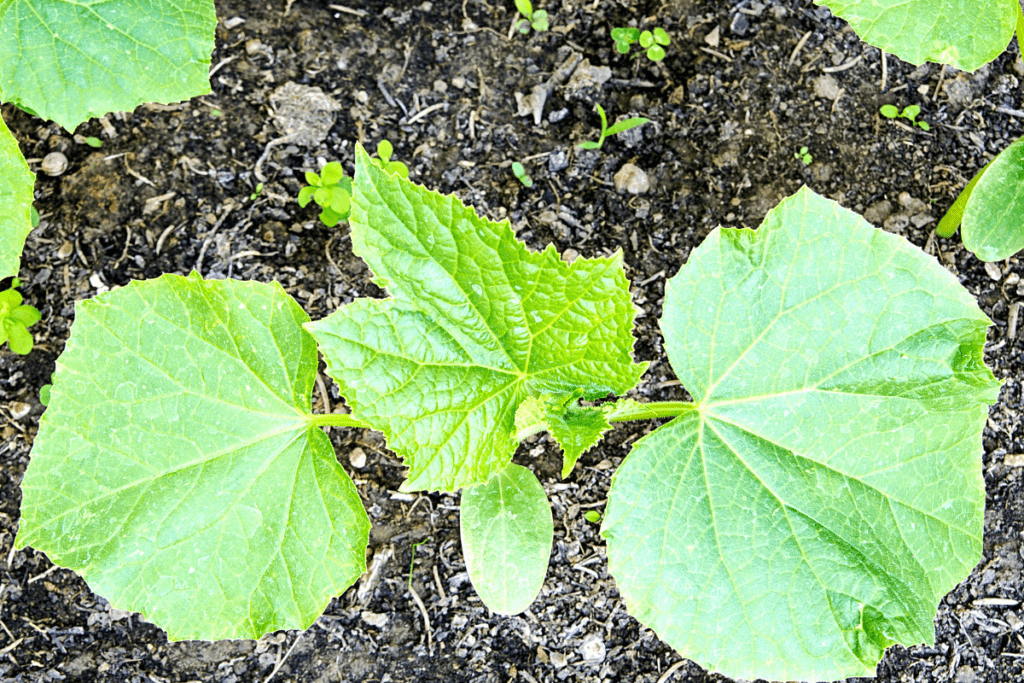
What not to plant with cucumbers
Apart from tomatoes, there are several other plants that you shouldn’t plant near your cucumbers:
– Brassicas
Brassicas like brussels sprouts, cabbage, cauliflower, kale, and kohlrabi can disadvantage your cucumber’s growth. They are generally very water-thirsty plants and might compete for the water in the soil.
– Melons
Similar to tomatoes, melon plants suffer from many of the same pests as cucumbers. Planting the two next to one another can attract those pests even more.
– Potatoes
Potatoes are heavy feeders and take up a lot of water, so they will compete immensely for the same nutrients if planted next to your cucumbers. In addition, potatoes can also quickly become diseased with phytophthora blight.
– Sage
Apart from oregano and dill, many aromatic herbs interfere with cucumber plants in the garden—and sage is perhaps the worst offender. It may actually affect the flavor profile of your cucumbers.
– Fennel
While fennel can attract beneficial insects, it can serve as an inhibitor to the growth of your cucumbers.
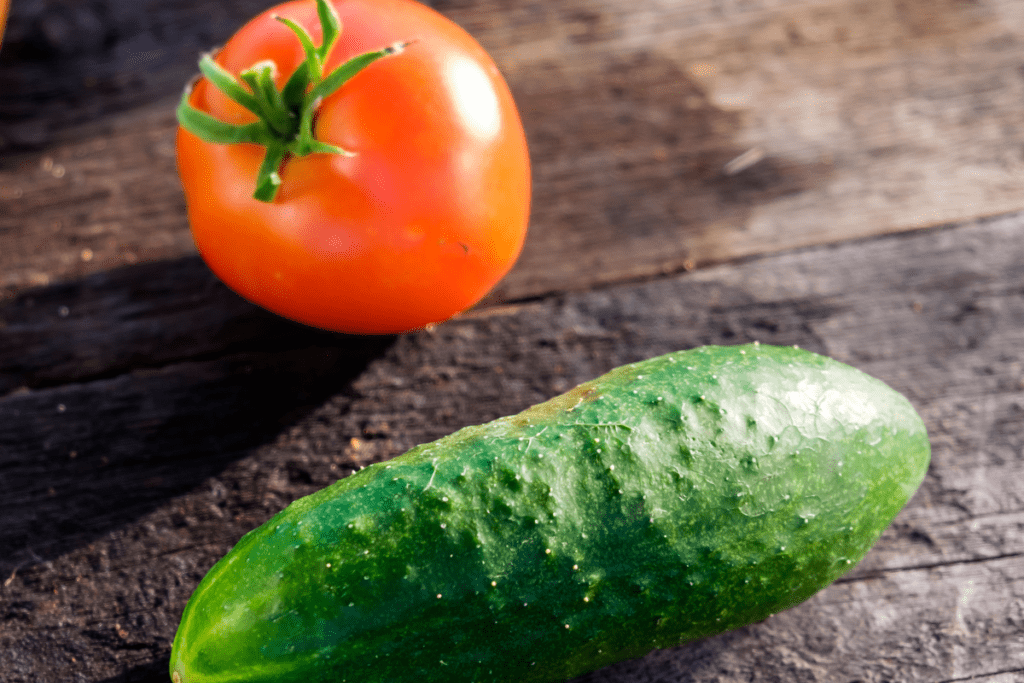
Related questions
Can peppers and cucumbers be planted together?
Even though peppers and cucumbers enjoy similar growing conditions and seem like great companion plants, it is not recommended to plant them near each other. The main reason is the high possibility of shared diseases such as phytophthora blight.
Instead, space them apart in your garden and choose different, safe companion plants for each species.
Can zucchini and cucumbers be planted together?
It is not recommended to plant zucchini near cucumbers due to the high possibility of shared diseases such as phytophthora blight. If you want to grow both in your garden, space them far apart and choose other companion plants in between them.
What not to plant next to tomatoes?
Likewise, you shouldn’t plant tomatoes and zucchini together for the same reasons.
Can you plant potatoes and tomatoes together?
Potatoes are also at high risk of becoming diseased with Phytophthora Blight and therefore shouldn’t be planted together with tomatoes. Besides, potatoes are heavy feeders and will compete with the tomatoes for the same nutrients in the soil.



